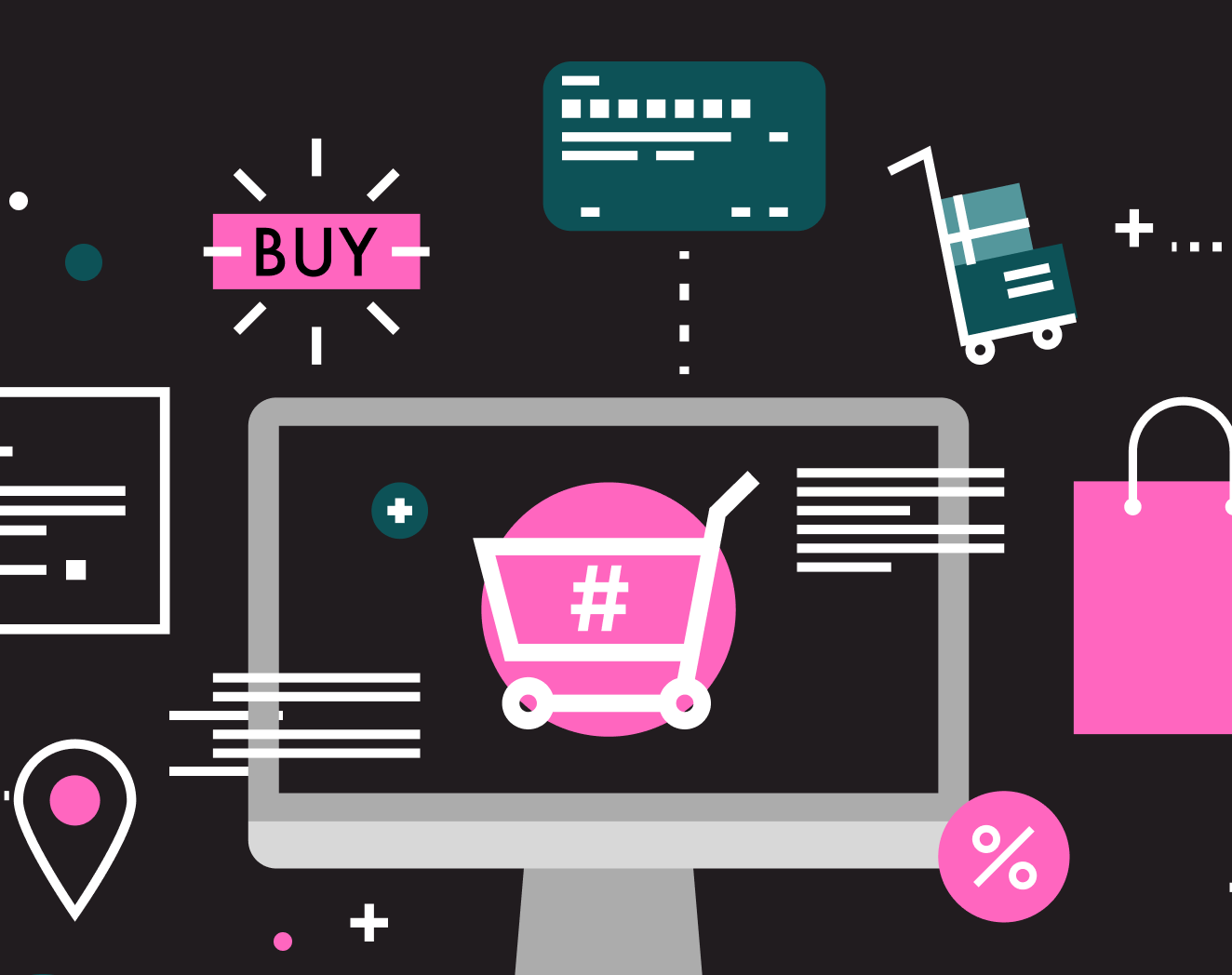User-Generated Content Examples To Inspire Your Marketing
User-Generated Content Examples To Inspire Your Marketing
- Why User-Generated Content?
- 8 Brand User-Generated Content Examples
- Nike
- Asos
- SheIn
- Starbucks
- Canon
- Lush Cosmetics
- Trek Bikes
- Capella Hotels & Resorts
- User-Generated Content Ideas
- Social Media
- UGC Contest
- Website
- Make it Shoppable
- Product Pages
- Creator Community
- Conclusion
Most people know about user-generated content (UGC), and how marketing teams are increasingly using it to make their branding more authentic and relatable.
However, when it comes to dreaming up a UGC strategy, figuring out how to best put this kind of content to good use can leave some marketers scratching their heads.
In this post, we feature hallmark user-generated content examples from big brands and explain why each strategy is effective. Seeing the many ways brands choose to use UGC for their marketing should help give you some inspiration on how to make UGC an effective part of your brand’s marketing strategy.
Why User-Generated Content?
First, let’s touch on why user-generated content is becoming increasingly popular among brands both big and small.
In our latest data report, 83 percent of consumers say they believe retailers need to provide them with more authentic shopping experiences, and 59 percent of consumers say they find user-generated content to be the most authentic.

What’s more, 79 percent of people say UGC highly impacts their purchasing decisions, while a mere 9 percent say influencer content impacts purchasing decisions.
To put it simply, consumers know what content and experiences they want from brands. In the same report, 72 percent of consumers say real customer photos and videos are the content they most want to see on eCommerce sites, and 80 percent say they would be more likely to purchase a product from an online store if its website had photos and videos from real customers.
Not only is UGC authentic and proven to inspire consumers to take real action, but it is also highly cost-effective. UGC is abundant, and people generate it freely—all brands have to do is request permissions.
User-generated content has consistently proven to be the kind of content that resonates the most with the lifestyles of real people and enables brands to deliver more personalized and relevant shopping experiences at scale.
8 brand user-generated content examples
These are user-generated content examples from well-known brands using it to amplify their marketing efforts. Learn how brands have leveraged UGC to serve more than just one purpose—from creating more inspiration and engagement to bringing together a community to drive purchases.
Nike
Nike is one of the first big brands to really harness the power of the content generated by its customers and followers.
#JustDoIt
We all know this hashtag. #JustDoIt has over 15 million Instagram posts and even more across other social media networks. The #JustDoIt campaign is the primary evergreen way Nike generates user-generated content around its brand.
PHOTOid Campaign
In 2017 Nike created one of its first UGC campaigns. They created a tool that allowed customers to submit their favorite Instagram photos. Then, Nike used the color scheme from those uploaded photos to create customized images of their Air Max shoes. Users were encouraged to share the custom image online with the #airmax hashtag—generating over 100,000 shoe images with the tool in the first week.

This campaign provided a fun way for people to create personalized versions of a Nike product and empowered followers to be creators too. All while growing awareness and engagement around the Nike brand.
Better For It Campaign
In one of its most impactful and targeted campaigns to date, Nike again tapped into the power of its audience, this time to create a social media movement dedicated to its women’s division. Nike created the #betterforit hashtag and prompted women to share their workout, health and fitness goals. To this day, the hashtag has garnered hundreds of thousands of posts.
This UGC campaign was a way for Nike to perpetuate its brand values of encouraging athleticism. Just two months after the campaign launched, Nike’s women’s division saw a 20 percent lift.
Asos
Asos is an eCommerce website that powers its Instagram feed with real customers using its hashtag #AsSeenOnMe.

For many, Asos’ feeds are a refreshing mix of content from real-life customers donning Asos apparel and accessories peppered with branded content. In doing this, Asos secures free advertising and can present a more authentic image of the brand that its audience finds more relatable and authentic.
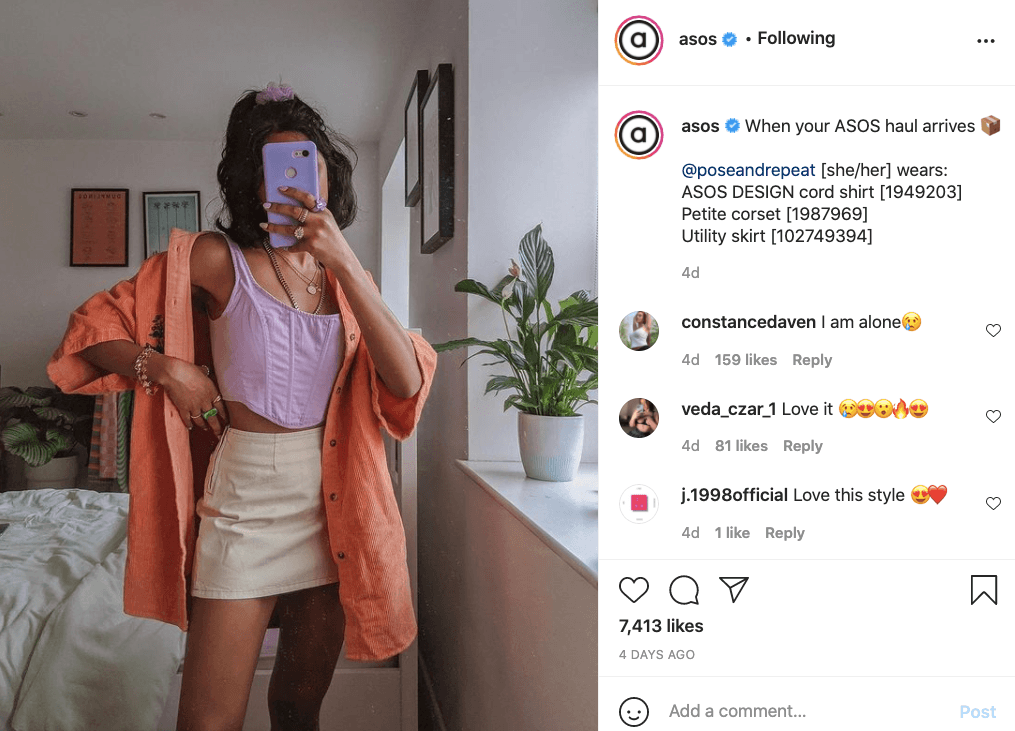
Plus, ASOS makes the user journey even easier by including searchable product codes within the captions so browsers can quickly transform into active shoppers and buyers.
SheIn
Across its TikTok and Youtube channels, SheIn is a fashion brand that has become well-known for its “clothing hauls”—a user-generated content strategy where real customers show off the clothes they bought on SheIn. This tactic has helped the brand form a global community around its broad product offerings.

The reason SheIn clothing hauls are one of the brand’s most successful marketing strategies is that consumers get to see the SheIn clothes on real customers as they try them on and review them.
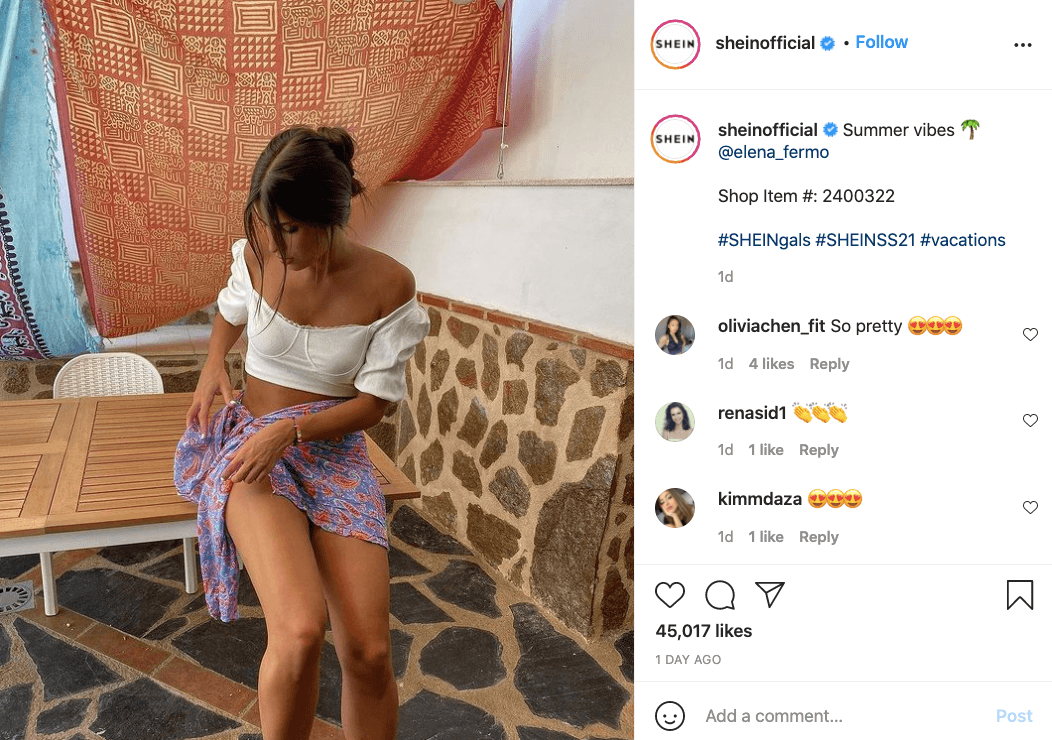
SheIn also promotes the hashtag #SHEINgals to incentivize customers to share SheIn outfit ensembles on social media for a chance to be featured in its social media feeds. Like Asos, SheIn makes it easy for users to track the specific product featured in a social post by having searchable product numbers in every caption.
Starbucks
The user-generated content marketing campaigns Starbucks has run over the years have become pretty popular. One notable one is its annual #RedCup contest, where the brand encourages customers to post photos on social media of themselves with their holiday-themed red Starbucks cups. What’s great about this campaign is that people are free to get creative with it.

In 2015, Starbucks enhanced this campaign by creating a Christmas tree of red Starbucks cups at King’s Cross Station in London—prompting many people to take selfies in front of the gingerbread-scented red cup display.
Curating all the #RedCup contest photos with Stackla, Starbucks then displayed those engaging images in digital-out-of-home (DooH) billboards throughout London’s railway stations to inspire commuters to purchase a cup as they walked by.

This is a great example of a UGC campaign that one brand made multi-sensory—crossing the boundary between the real and virtual worlds to give audiences multiple ways to participate.
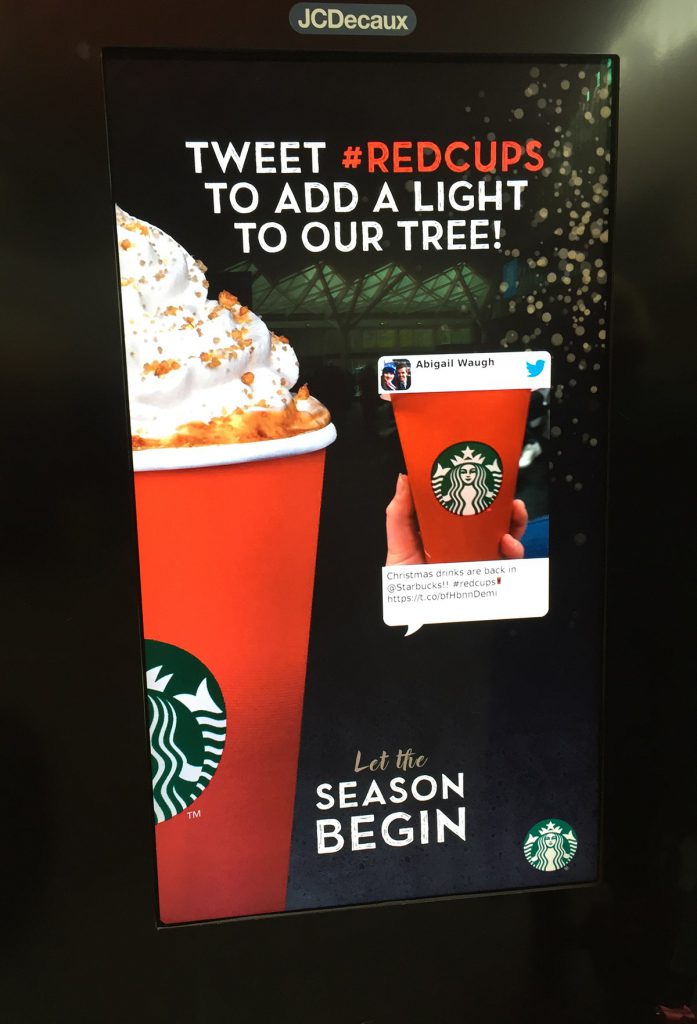
Canon
Canon Australia put UGC at the heart of its digital strategy to bring together its community of novice and professional photographers.
The Canon team wanted to focus its marketing efforts on the post-purchase experiences of its customers since they knew how influential peer-to-peer product recommendations can be.
Jensen Baptista, Senior Manager at Canon Australia, said, “What triggered the rise of user-generated content within Canon Australia was our decision to stop focusing on our products, and start focusing on the people who use them.”
Canon placed an inspiration page on its site to showcase the content of its passionate community and to tell the myriad stories behind the photographs and film. They have a form on their website inviting content creators to upload their submissions.
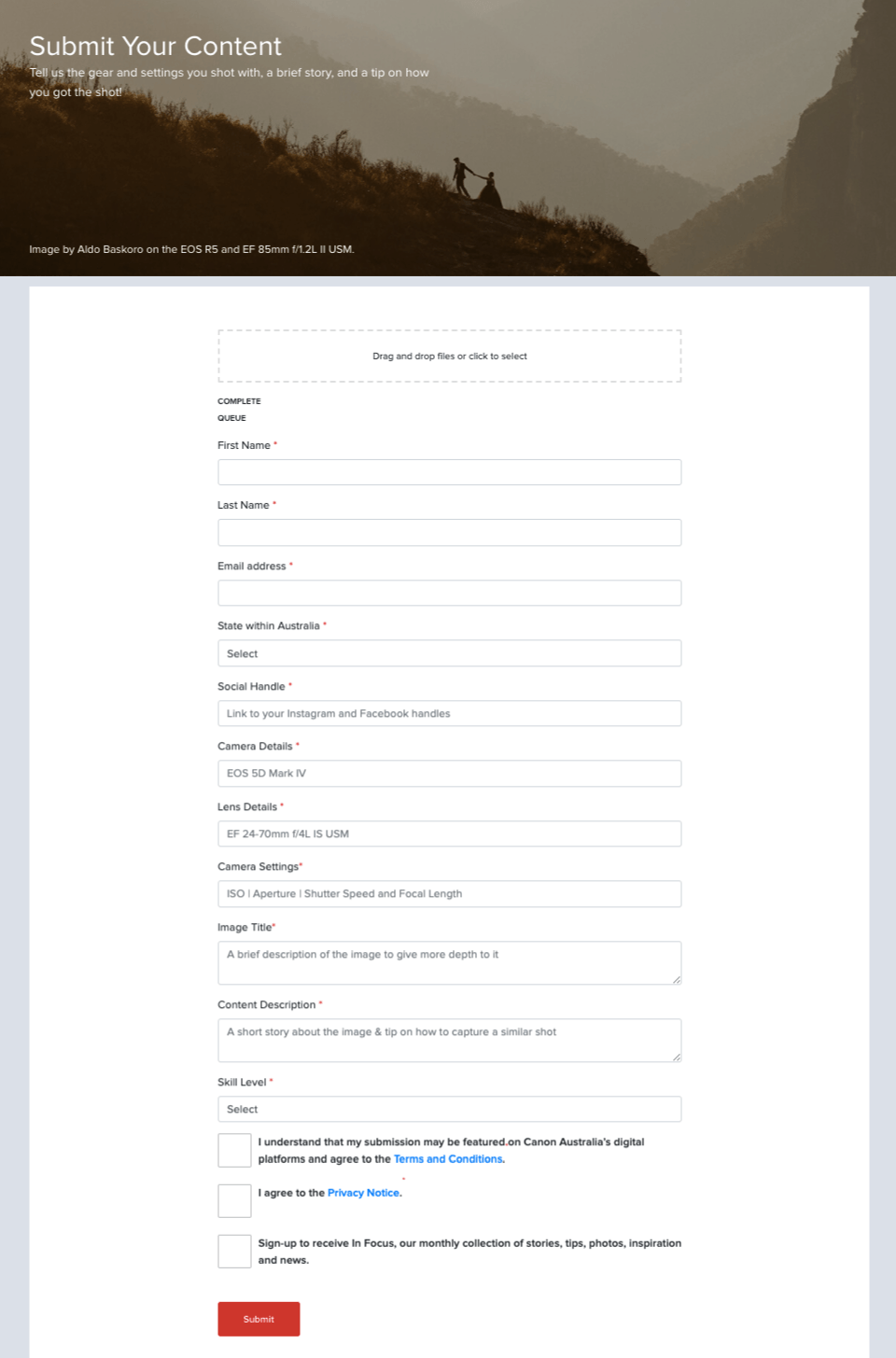
Canon has also run UGC photo challenges to keep its audiences engaged. One of note is its Take the LEAP challenge in which they created 30 briefs—a new one for each day of the month—which prompted thousands of people to share their content and creativity.

What was great about this challenge was that it didn’t require someone to have a Canon camera in order to participate. The goal was to simply get people thinking creatively about photography to stir their interest in the medium since most have a smartphone they can use.
Canon Australia’s Instagram feed is fed primarily by user-generated content. As of this writing, their social media strategy is largely UGC-driven.
Lush Cosmetics
Because they are socially and environmentally conscious, Lush Cosmetics has a highly enthusiastic fan base of customers that regularly share content.
Their unique product packaging and line of natural bath bombs that turn people’s bathtubs into multicolor rainbows are the kind of thing that is ripe for social media sharing.

Lush decided to capitalize on its Instagram-ready products by letting their customers, aptly known as ‘Lushies,’ speak for the brand. They completely replaced their traditional advertising with high-performing user-generated visuals of their products, even prominently featuring shoppable UGC images on their product detail pages.

This makes Lush a more consumer-driven brand and has the added bonus of building engagement and community around its products. UGC also helps Lush deliver personalized content experiences at scale, as they defer to their audience to generate a diverse array of content to serve the right customers at the right time.
Lush also works to build strong relationships with happy customers through its ambassador program called #FirstLookLushies. Here they acknowledge and encourage those already creating content for the brand to continue engaging.
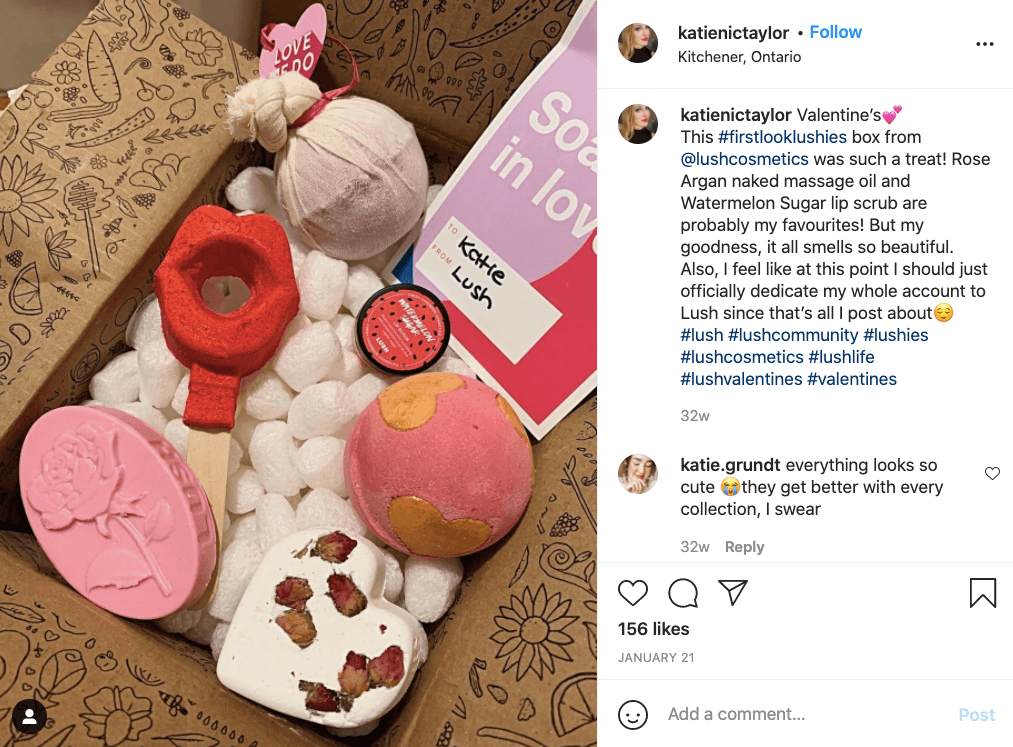
Sabine Schwirtz, former community manager at LUSH Cosmetics North America, said, “The voice of the brand is not always the same as the voice of the customers. We’re moving closer to times where a brand’s identity is the same as their customers’ identity.”
Trek Bikes
Trek Bicycle uses UGC to help promote a cause. They created a campaign called #GoByBike to help inspire collective action—inspiring people to use bicycles to combat the challenge of climate change.
Trek Bicycle encouraged people to participate in the competition by featuring UGC from its community on the website and social media channels including Instagram Stories.

Haley Gustafson, Social Media Manager at Trek Bicycle, said, “We realized that people are more likely to implement a behavior if they see other people—especially people like themselves—participating and taking that action.”

When COVID-19 hit, it gave even more fuel to the campaign as people were looking for safe ways to be outside and drew even greater awareness around sustainability and the benefits of biking.
After only seven weeks of the #GoByBike campaign, Trek Bikes saw 17,000 uses of the hashtag and received the rights to over 2,000 unique pieces of UGC from Instagram alone.
Capella Hotels & Resorts
Capella Hotels and Resorts decided to use UGC across not just one, but several of its marketing touchpoints—and it paid off. Their main goal with UGC was to craft more authentic online experiences to build brand awareness and increase bookings. They integrated user-generated visuals into their email, social media channels and website and saw a 40 percent increase in online revenue.
Terence Wu, Capella’s Corporate Director of eCommerce & Digital Marketing, said the focus of luxury hotels was becoming less about the ornate decorations and fancy amenities and “more about the moments these properties create for families and people to get together.”
They encouraged guests to use the branded #CapellaCandids hashtag on social media, which they then used to create an inspiration page on the website.

They also implemented UGC from specific hotel stays into the respective email newsletters for those properties to give people a more authentic visual experience of those destinations.
For its family packages, Capella also replaced professional imagery with UGC to make those marketing campaigns more relatable, resulting in a 4.5x increase in revenue for those packages.
In total, by using the Stackla platform, Capella was able to aggregate over 30,000 pieces of UGC and add over 4,000 visuals to their asset library—providing them with plenty of content to use in multiple omnichannel marketing campaigns.
User-Generated Content Ideas for Your Marketing
In addition to the above examples, here is a list of go-to user-generated content ideas to inspire your marketing.
Flood your social media channels with customer and fan content for higher engagement
If you’re just starting out with UGC, social media is a great channel to experiment with first. You can begin by mixing in some customer visuals with your other content and see what your audience responds to most. Are you getting more likes on UGC posts? Are people commenting or sharing these visuals more? Does the engagement level differ depending on the social platforms (Snapchat, Instagram, Facebook, Twitter, etc.)?
Featuring UGC throughout your social media channels can be a great precursor to identifying how effective a wider UGC strategy across your other marketing materials might be.
Generate UGC with a contest
Contests and competitions are a superb way to generate a lot of UGC for your brand and get people engaged. Contests also create a lot of hype and excitement, which can increase brand awareness. It’s a win-win-win strategy that many brands have seen success with.
Typically, any UGC contest will include an original dedicated hashtag that people can use to participate, and that your brand can use to gather and choose from the best visuals submitted.
Another way to have people participate is by asking them to @mention or tag your brand in their photos, or by simply adding a direct upload form to your website. Don’t forget to have a plan for rewarding your winners! It could be a giveaway, a free trip or the chance to have the winning photo featured across your marketing channels.
Want to use all the photos your audience submits throughout your contest? Build content permissions into the terms and conditions of the contest participation. This gives you automatic rights to use all the content fans share with you.
Add inspiration and authenticity to your website pages
Give your website pages a little more pizazz and authenticity by placing real customer UGC on key web pages. Many brands choose to use a UGC widget on top pages. For example, Stackla customer iCanvas, an art eCommerce company, invites customers to upload their photos of products they purchased or share them on social with the #iCanvas hashtag to be featured on the home page.
Having customer UGC placed on your website, specifically in the form of a gallery, has shown to consistently improve time on page, bounce rate and on-site engagement (people clicking on the image to discover more or clicking the ‘load more’ button).
Allow people to click-to-buy with shoppable UGC
Make your UGC even more impactful by enabling a click-to-buy feature on real customer images featuring a specific product.
In our data report, 71 percent of people say they would be more likely to buy from an online store if it made it easy to buy an item directly from an inspirational image.

Since UGC is some of the most authentic and popular content among consumers, taking those visuals to the next level by making them shoppable could give your brand a boost in sales.
Furthermore, making an inspirational UGC shoppable gives consumers what they want by creating a more seamless shopping experience. Shortening the pathway to purchase not only makes it easier on consumers but can increase your brand’s conversation rates, too.
Give your product pages added social proof
At this point, consumers expect to see real customer UGC when they go to a product detail page. Since you can’t feel, try or test items when shopping online, seeing photos and reading reviews from others who have purchased a certain product helps people in their decision to buy. Displaying social proof alongside professional product images can help instill trust, which can both increase conversions and decrease return rates.
You can identify UGC of specific products shared on the Internet and you can also invite people to upload photos of the product they purchased after they’ve made the transaction to increase the amount of social proof you include on product pages.
Build a community of creators
Gather together a group of champions for your brand. You can do this by identifying those that have already published content celebrating your products and invite those engaged people to join your brand community.
In our latest data report, 65 percent of Gen Z say they would be likely to join a customer advocacy group to actively help create content for brands they buy from. People can develop closer ties with your brand when they are invited to play a part in creating it. Not only does this encourage greater loyalty from your most enthusiastic customers, but it also creates new ways for that enthusiasm to spill over for more people to see.
Plus, once you have a program all set up for your brand advocates, you can then give them prompts to create more specific UGC to continue filling your need for content.
Conclusion
We hope these user-generated content examples from big brands prove inspirational to your marketing strategy. UGC is a great way to establish trust in your brand, engage existing followers, grow your audiences and increase your chances of someone making a purchase. So, don’t be afraid to take chances and experiment with it!
If you’re interested in leveling up your UGC game with a robust tool to be your one-stop shop for all things UGC, fill out a demo form below to see what Stackla can do for your brand.

